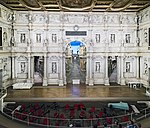Villa Trissino (Cricoli)

The Villa Trissino is a patrician villa, which belonged to Gian Giorgio Trissino, located at Cricoli, just outside the center of Vicenza, in northern Italy. It was mainly built in the 16th century and is associated by tradition with the architect Andrea Palladio. Since 1994 the villa has been part of a World Heritage Site, designated to protect the Palladian buildings of Vicenza. In 1996 UNESCO extended the site "Vicenza, City of Palladio" to cover the Palladian Villas outside the core area and renamed it as "City of Vicenza and the Palladian Villas of the Veneto". This villa is not to be confused with the similarly named Villa Trissino some 20 km away at Sarego, an incomplete building that Palladio designed for Ludovico and Francesco Trissino, as documented in I quattro libri dell'architettura ("The Four Books of Architecture").
Excerpt from the Wikipedia article Villa Trissino (Cricoli) (License: CC BY-SA 3.0, Authors, Images).Villa Trissino (Cricoli)
Strada Marosticana, Vicenza San Bortolo
Geographical coordinates (GPS) Address Nearby Places Show on map
Geographical coordinates (GPS)
| Latitude | Longitude |
|---|---|
| N 45.565277777778 ° | E 11.546944444444 ° |
Address
Strada Marosticana 7
36100 Vicenza, San Bortolo
Veneto, Italy
Open on Google Maps










